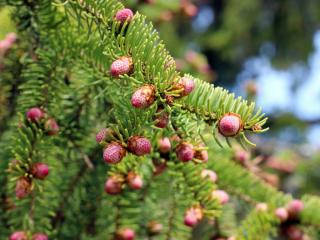

Black spruce is used for its health benefits, and medicinal, therapeutic activity.
A tall tree that is very common in Europe and Canada, black spruce (in Quebec) or simply spruce (in Europe) grows on chalky or limestone soil, is hardy to the cold and survives in high altitudes. It reaches 100 feet (30 m) and has a lifespan of 5 centuries.
A prized collection for American Indians, gummy sap collected from black spruce was chewed on by women to maintain the whiteness of their teeth.
As for men, they simply liked chewing it.
Quebec is where black spruce is native from. This tall tree is also planted in parks and in private gardens.
In France, Switzerland and Italy, only a single spruce species is found: common spruce. The Alps is the mountain range where this tree can be found.
However, in this article, we’ll mostly be dealing with the medicinal properties of this plant. What exactly is all this about? What ailments can this tree naturally cure? How does it work and why?
Here is what you need to know…
The generic name Epicea means “the tree that produces pitch”.
Etymology teaches us that this name comes from ancient Latin “picea”, which actually gave the French name “épicéa” directly, and indirectly led to the current English word “spruce”. It’s quite common in mountain ranges, and city folks often first encounter it as a Christmas tree.
Whether it’s “white” or “black”, this tall tree belongs to the Pinaceae family and boasts many health benefits.
Famous for its diaphoretic (sweating) and expectorant properties, young black spruce growth was ingested as a drink by the American Indians to cure cough.
Young twigs were also added to bathwater to help the body absorb the sedative properties.
Moreover, they attributed significant purgative activity to this plant.
 In France and in Canada, spruce sap served as a remedy against inflammation of the nasal and pharynx mucus tissues, when breathing became difficult and to treat other respiratory tracts diseases.
In France and in Canada, spruce sap served as a remedy against inflammation of the nasal and pharynx mucus tissues, when breathing became difficult and to treat other respiratory tracts diseases.
For the people of Quebec, spruce chewing gum is know for its powerful antiscurvic activity and also because it eases digestion.
Also, it is also very good at treating motion or sea sickness.
On the European side of the pond, another spruce species “Picea abies” was used in medicinal baths.
Young saplings and needles from trees aged 60 to 80 years old were paired and used. In needles from the older trees, active ingredients were particularly concentrated. The goal was to treat rheumatism and disorders due to a deficient nervous system.
Have you ever heard of black spruce beer?
Fermented for 24 hours, this drink is a spruce extract known for its slightly laxative properties. But it is most savored for its refreshing taste!
Often recommended to soothe cough, the expectorant activity of black spruce are also present in black spruce syrup.
You can easily prepare it yourself. How best to proceed?
Some plants are able to cure and soothe ailments. However, it’s important to verify your course of action with an expert (herbalist), a pharmacist and especially your consulting physician for him or her to provide you with the medical standpoint on your situation.